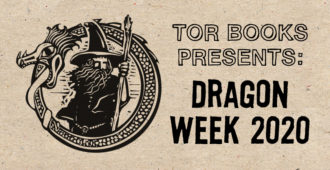From the newly released Tropic of Serpents and the first book in the series A Natural History of Dragons, readers know Isabella, Lady Trent, to be the world’s preeminent dragon naturalist. She is the remarkable woman who brought the study of dragons out of the misty shadows of myth and misunderstanding into the clear light of modern science. The world of Lady Trent is home to a myriad of different dragon species, from the fire-breathing desert drakes of Akhia to the tiny draconic cousins known as sparklings. Now you have a chance to expand the borders of dragon naturalism, by adding your own species to the mix!
All you have to do is invent a breed of dragon or draconic cousin that might fit into Lady Trent’s world. Write up a description of no more than two hundred words covering its appearance and habitat, any noteworthy behaviors, and so on. Then submit your invention to dragons.of.trent@gmail.com , with the header “DRAGON: {name}”. Marie Brennan will select one to three entries and reference them in a future installment of the Memoirs of Lady Trent. Winners will also receive a signed Advance Reader Copy of Voyage of the Basilisk, the third book in the series, when those become available (late 2014).
This contest is open to entrants worldwide. No more than three submissions per entrant; any subsequent e-mails will be deleted unread. The contest will close to entries at 11:59pm EST on May 15, and winners will be announced on May 26.
Here’s an example from Marie Brennan:
WYVERN — A reptilian creature native to northern and eastern Anthiope, possessing hind limbs and wings, but lacking forelimbs, which disqualifies it for consideration as a “true dragon” under the criteria of Sir Richard Edgeworth. Wyverns are typically 3-4 meters in length from nose to tail, with a comparable wingspan, and light of build through the chest. Their coloration is mottled brown and green, for protective colouration in the treeless hills that are their usual habitat. They typically hunt by waiting in an elevated position and then launching into the air when prey is sighted. Their venom is paralytic, and kills the prey through asphyxiation. Wyverns are solitary except when they mate, but the male will follow the female until she lays her eggs, after which they incubate in the care of the male, who feeds them and teaches them to hunt after hatching. Juveniles rarely stay with their father for more than three months, by which point they are capable of independent sustenance.








What about creative rights? If we enter and are chosen to win would we lose rights to that breed, or could we use the breed in our own works for publication later? Thank you.
Hi Randi – we suggest directing that question to the email address provided, dragons.of.trent@gmail.com.